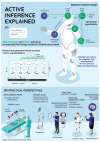How Active Inference Could Help Revolutionise Robotics
- PMID: 35327872
- PMCID: PMC8946999
- DOI: 10.3390/e24030361
How Active Inference Could Help Revolutionise Robotics
Abstract
Recent advances in neuroscience have characterised brain function using mathematical formalisms and first principles that may be usefully applied elsewhere. In this paper, we explain how active inference-a well-known description of sentient behaviour from neuroscience-can be exploited in robotics. In short, active inference leverages the processes thought to underwrite human behaviour to build effective autonomous systems. These systems show state-of-the-art performance in several robotics settings; we highlight these and explain how this framework may be used to advance robotics.
Keywords: Bayesian inference; adaptive robots; filtering; free energy; generative model; model-based control; neurotechnology.
Conflict of interest statement
The authors declare no conflict of interest.
Figures

References
-
- Barp A., Da Costa L., França G., Friston K., Girolami M., Jordan M.I., Pavliotis G.A. Geometry and Statistics. Academic Press; Cambridge, MA, USA: 2022. Geometric Methods for Sampling, Optimisation, Inference and Adaptive Agents.
-
- Buckley C.L., Kim C.S., McGregor S., Seth A.K. The free energy principle for action and perception: A mathematical review. J. Math. Psychol. 2017;81:55–79. doi: 10.1016/j.jmp.2017.09.004. - DOI
Grants and funding
LinkOut - more resources
Full Text Sources
Other Literature Sources

